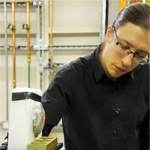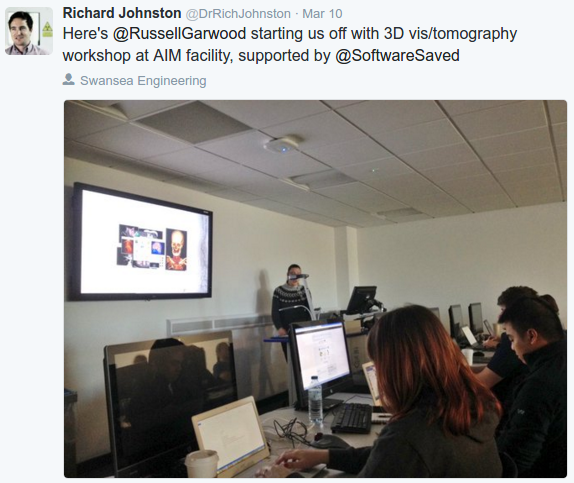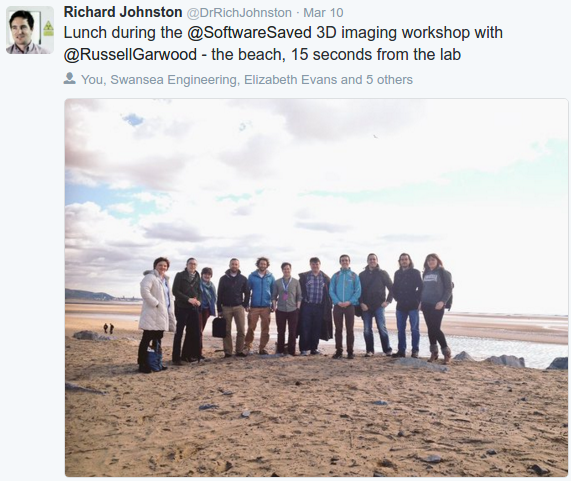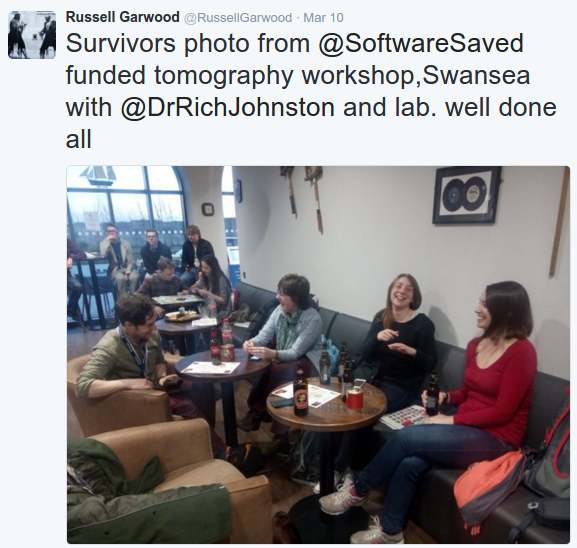Open source tomography training: Swansea & Leicester 2016
Posted on 22 April 2016
Open source tomography training: Swansea & Leicester 2016
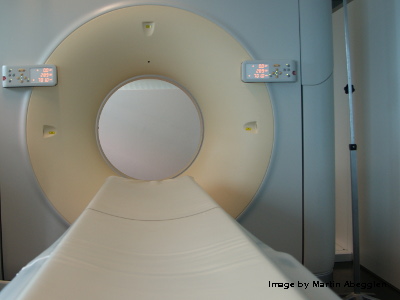 By Russell Garwood, Lecturer at the University of Manchester.
By Russell Garwood, Lecturer at the University of Manchester.
2015 Software Sustainability Institute fellow Russell Garwood has completed his fellowship by giving two institute-sponsored training courses in using open source software, showing how to analyse and visualise tomographic datasets. By learning the basics of Drishti, SPIERS and Blender, attendees have many of the tools needed to conduct research using tomography data, avoiding expensive proprietary software.
Previous blog posts have highlighted the fact that CT scanning is an ever-more accessible tool for imaging in numerous fields, from archaeology to zoology. As scanning has become increasingly cheap, the high cost of software to visualise and analyse data has developed as a primary factor limiting the uptake of CT. On this basis, I have been offering training in freely available software. Over the course of my fellowship I have given training on numerous packages in Bristol and Cardiff - primarily to Palaeontologists, a field in which CT has been revolutionising the study of three-dimensionally preserved fossils. My hope is that this lessens the often steep learning curve for these software packages, and helps further establish these open source tools within the CT community. I’ve finished my fellowship with two training courses in different parts of the UK, outlined below.
Swansea
In Swansea twenty attendees learned the basics of Drishti, SPIERS and Blender for visualising CT data. SSI fellow Rich Johnston organised the Swansea-end of arrangements, and highlighted that the attendees were largely “PhD/EngD students, postdoctoral researchers (both academic and industry based), including a Dorothy Hodkin Fellowship holder, and academics. These included staff at Swansea and a researcher from Cambridge University”. Those in attendance had widely variable backgrounds, and included researchers from materials science, engineering, biosciences, geography, mathematics, and life sciences. The day started with a tour of the Advanced Imaging of Materials Facility, which played host to the workshop. The facility is a £9M EPSRC/Welsh Government-funded integrated scientific imaging facility that can provide imaging and analytical capabilities across several length scales from Angstroms to centimetres. After the tour attendees had an overview of the many open source tools out there, above and beyond those featured in the training sessions:
After this, and before lunch, I introduced key steps in data preparation - using Drishti Import to modify and then export data for different software packages. I also introduced volume rendering voxel data in the main Drishti package. There was then a break, during which all attendees were treated to lunch by the SSI, and we went on a quick tour of the new Swansea University Bay Campus, including their very own beach:
After lunch, a long afternoon was had, in which I introduced SPIERS - freely available software which is really useful for noisy and complex data, and use on non-workstation grade PCs, before finishing with a brief introduction to the hugely versatile CGI/raytracing software Blender. After the workshop most people had to head home, but a few hardy souls went out for dinner to celebrate the success of the workshop:
For context to the day, Rich highlighted how open source software fits into the facility and its operation. “The Facility can provide a fully-coupled micro/nano-analysis workflow via a state-of-the-art advanced correlative imaging (combining different data sets across length scales) with capability in transmission electron microscopy (TEM), scanning electron microscopy (SEM), Ion beam nanofabrication, X-ray Diffraction (XRD), X-ray Photoelectron Spectroscopy (XPS), Energy-Dispersive X-ray Spectroscopy (EDS), and micro and nano X-ray computed tomography (microCT). The diverse research challenges that are investigated at AIM, particularly using X-ray imaging and the production of 3D data, brings us in touch with diverse researchers with varying understanding and training in the processing and analysis of large 3D data. Open software is extremely important to us; it can provide a common platform for us to analyse data and communicate with our many collaborators, therefore this training workshop was very useful and also attracted a lot of interest from our collaborator base and further afield. We thank the SSI and Russell for their support and time in bringing this workshop to Swansea.” Indeed, the training was being put to use within a week by members of the facility:
Leicester
Leicester was a very different event. Similar training - in SPIERS and Drishti - was required, but I provided this for a single person. Cheryl Haidon is the person for members of the Geology Department at Leicester who need to conduct CT scanning. She says “I am responsible for guiding and training students from the Department of Geology here at the University of Leicester in the acquisition and processing of CT data. Both masters and PhD students have a strong requirement for such data, and they will benefit greatly from having ready access to open-source software such as Drishti and SPIERS. To that end, it was extremely useful for me to be able to learn the basic principles of both these packages, so that I can disseminate this knowledge to the students, who will in turn develop their own expertise in this rapidly-expanding technique. I will be investing considerable effort over the next few weeks in consolidating the topics we have covered, and developing my own fluency and expertise so that I can become the local ‘expert’ for all members of the Department - students and staff alike - who have an interest in microCT.” Hence, this provided the opportunity through two days of intensive training, to establish local expertise in open source software, which will provide a lasting and very real difference to workflows for CT data at the University of Leicester.
With that, I have finished my SSI fellowship! I hope, that with the SSI’s support, this work has made a difference to CT users in the UK community, who can now use open source software to understand, visualise and analyse their data. I will continue providing this training, in the hope that with more widespread expertise of open source CT software in the UK the price of proprietary tools need not hold us back when applying tomography to a multitude of different specimens.

